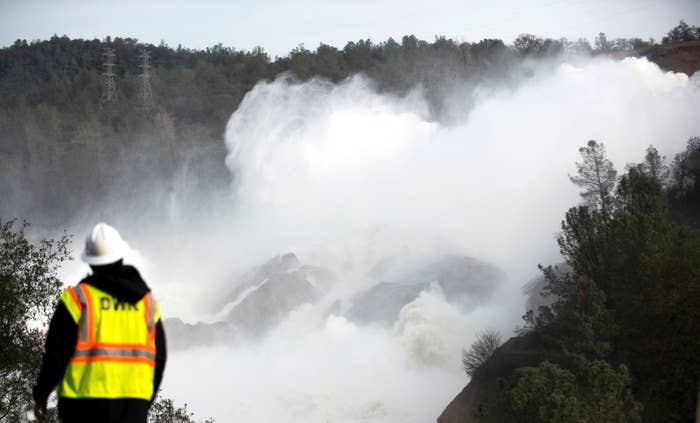Category: EARTHQUAKES
Largest earthquake in decades hits Southern California, measuring 6.4 magnitude JULY 4, 2019
EARTH QUAKES – PLANNED Fake Lakes Make Quakes – and this is known! Orville Dam Planned Breach
Dam Collapses and Earthquakes: California’s Major Dams Face Risks Of Floods And Failure Due To Climate Change . . .
https://www.buzzfeednews.com/article/danvergano/california-dams-climate-change

The Oroville Dam’s overflow channel failed in 2017.
Major dams in California are five times more likely to flood this century than the last one due to global warming, a new study finds, possibly leading to overtopping and catastrophic failures that threaten costly repairs and evacuations.
Report: Climate-Safe Infrastructure Based on FALSE Science of Climate Change vs. Climate Control = Weather Weapons . .
Paying it Forward:
The Path Toward Climate-Safe
Infrastructure in California
DRILLING AMERICA for PROFIT and EARTHQUAKES: Trump Drilling Plan Threatens 9 Million Acres of Sage Grouse Habitat – The New York Times December 6, 2018

Trump Drilling Plan Threatens 9 Million Acres of Sage Grouse Habitat
A plan to strip protections for the imperiled bird would open more land to drilling than any other step the administration has taken, experts said.
OIL is a RENEWABLE: Oil Fields Are Refilling… Naturally – Sometimes Rapidly « Aletho News
Oil Fields Are Refilling… Naturally – Sometimes Rapidly
EXCERPT:
Deep underwater, and deeper underground, scientists see surprising hints that gas and oil deposits can be replenished, filling up again, sometimes rapidly.
Although it sounds too good to be true, increasing evidence from the Gulf of Mexico suggests that some old oil fields are being refilled by petroleum surging up from deep below, scientists report. That may mean that current estimates of oil and gas abundance are far too low.
Recent measurements in a major oil field show “that the fluids were changing over time; that very light oil and gas were being injected from below, even as the producing [oil pumping] was going on,” said chemical oceanographer Mahlon “Chuck” Kennicutt. “They are refilling as we speak. But whether this is a worldwide phenomenon, we don’t know.”
Trump Order Calls for More Offshore Drilling | Coastal Review Online – Creating Earthquakes . .
xecutive Order Regarding the Ocean Policy to Advance the Economic, Security, and Environmental Interests of the United States | The White House
EXCERPT:
The ocean, coastal, and Great Lakes waters of the United States are foundational to the economy, security, global competitiveness, and well-being of the United States. Ocean industries employ millions of Americans and support a strong national economy. Domestic energy production from Federal waters strengthens the Nation’s security and reduces reliance on imported energy. Our Armed Forces protect our national interests in the ocean and along the Nation’s coasts. Goods and materials that support our economy and quality of life flow through maritime commerce. Our fisheries resources help feed the Nation and present tremendous export opportunities. Clean, healthy waters support fishing, boating, and other recreational opportunities for all Americans.
Stabenow sends President reminder of Great Lakes drilling ban after Executive Order signed | WWMT
EXCERPT:
WASHINGTON, D.C. — An executive order signed by President Donald Trump on Tuesday reversed an Obama-era policy that ordered for the protection of oceans and the Great Lakes.
U.S. Senator Debbie Stabenow (D-Michigan) sent a letter to the President on Wednesday to remind him that there is a permanent federal ban on gas and oil drilling in the Great Lakes.
“The economic and environmental significance of the Great Lakes cannot be overstated,” Stabenow wrote. “Our Great Lakes are the largest surface freshwater system on Earth, supply drinking water to over 40 million people, and sustain a $6 trillion economy and over 50 million jobs. Given the existing ban on drilling and the importance of the Great Lakes, I call on you to reverse course and oppose any efforts to open our waters to oil and gas drilling as a result of your recent Executive Order.”
EARTHQUAKES: Hazard Associated with Deep Well Injection – Report to the U.S. Environmental Protection Agency
https://pubs.usgs.gov/bul/1951/report.pdf
Earthquake Hazard Associated
With Deep Well InjectionA Report to the U.S. Environmental
Protection Agency
By CRAIG NICHOLSON and ROBERT L. WESSON
Prepared in cooperation with the
Environmental Protection Agency
Under certain circumstances, the increased pore pressure
resulting from fluid injection, whether for waste disposal,
secondary recovery, geothermal energy, or solution mining,
can trigger earthquakes. This report discusses known cases
of injection-induced seismicity and how and why earthquakes
may be triggered, as well as conditions under which the
triggering is most likely to occur. Criteria are established
to assist in regulating well operations so as to minimize
the seismic hazard associated with deep well fluid injection
U.S. GEOLOGICAL SURVEY BULLETIN 1951
